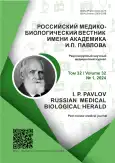Эпидемиолого-эпизоотологическая характеристика клещевого вирусного энцефалита и иксодового клещевого боррелиоза в европейской части России
- Авторы: Окунев Н.Д.1, Здольник Т.Д.1
-
Учреждения:
- Рязанский государственный медицинский университет имени академика И. П. Павлова
- Выпуск: Том 32, № 1 (2024)
- Страницы: 73-80
- Раздел: Оригинальные исследования
- URL: https://journal-vniispk.ru/pavlovj/article/view/254757
- DOI: https://doi.org/10.17816/PAVLOVJ568883
- ID: 254757
Цитировать
Аннотация
Введение. Иксодовый клещевой боррелиоз (ИКБ) и клещевой вирусный энцефалит (КВЭ) широко распространены в мире и в России и имеют существенную социально-экономическую значимость. Уровень заболеваемости населения данными инфекциями в значительной степени определяется эпизоотологической ситуацией, на формирование которой существенное влияние могут оказывать природные условия, создающиеся в определённой природно-климатической зоне.
Цель. Получение современной эпидемиолого-эпизоотологической характеристики ИКБ и КВЭ в территориальных образованиях европейской части России с разными природно-климатическими условиями.
Материалы и методы. В работе использованы материалы Государственных докладов «О состоянии санитарно-эпидемиологического благополучия населения» территориальных управлений Роспотребнадзора в европейской части России в 2012–2021 гг.
Результаты. Максимальными значениями инцидентности ИКБ и КВЭ (5,00 и 1,83 на 100 тысяч (тыс.) населения) характеризуется территория Северо-Западного федерального округа (СЗФО) России с природно-климатическими условиями зоны тайги. Вторую и третью позицию занимают Центральный (ЦФО) (4,53 и 0,34 на 100 тыс.) и Приволжский (ПФО) (3,59 и 1,11 на 100 тыс.) федеральные округа, территории которых включают несколько природных зон. В Южном (ЮФО) и Северо-Кавказском (СКФО) федеральных округах, значительная часть территории которых располагается в зоне степей и лесостепей, инцидентность ИКБ составляет 0,63 и 0,16 на 100 тыс. соответственно, заболеваемость КВЭ практически не регистрируется. Заболеваемость населения ИКБ и КВЭ коррелирует с долей укушенных клещами людей — в СЗФО коэффициент корреляции составил 0,89 и 0,74, в ЦФО — 0,65 и 0,68, в ПФО — 0,90 и 0,92. Соотношение инфицированности клещей, снятых с людей в СЗФО, возбудителями ИКБ и КВЭ составило 9,7:1,0. Суммарная среднегодовая площадь акарицидных обработок имеет максимальное значение в ЦФО — 14333,6 га. По территориальным образованиям европейской части России с наибольшей площадью акарицидных обработок выявлена обратная корреляционная связь данного показателя с долей укушенных клещами людей (r = -0,40).
Выводы. Эпидемиолого-эпизоотологические характеристики ИКБ и КВЭ в 2012–2021 гг. в территориальных образованиях европейской части России свидетельствуют о влиянии условий, связанных с принадлежностью территории к определённой природно-климатической зоне, на формирование эпизоотических очагов и заболеваемости населения данными инфекциями, что следует учитывать при планировании и осуществлении противоэпидемических мероприятий.
Полный текст
Открыть статью на сайте журналаОб авторах
Никита Дмитриевич Окунев
Рязанский государственный медицинский университет имени академика И. П. Павлова
Автор, ответственный за переписку.
Email: OkunevND@yandex.ru
ORCID iD: 0000-0003-1412-1244
Россия, Рязань
Татьяна Давыдовна Здольник
Рязанский государственный медицинский университет имени академика И. П. Павлова
Email: zdolnikt@mail.ru
ORCID iD: 0000-0002-5721-2544
д.м.н., доцент
Россия, РязаньСписок литературы
- Полищук М.В., Здольник Т.Д., Сметанин В.Н. Иксодовые клещевые боррелиозы: современная эпидемиологическая ситуация в регионах центра европейской части России // Российский медико-биологический вестник имени академика И. П. Павлова. 2017. Т. 25, № 2. С. 202–208. doi: 10.23888/PAVLOVJ20172202-208
- Симакова А.И. Иксодовый клещевой боррелиоз в Приморском крае // Тихоокеанский медицинский журнал. 2005. № 1. С. 68–71.
- Лищук Н.Г. Эпидемиология и профилактика иксодового клещевого боррелиоза //Региональный вестник. 2019. № 10. С. 7.
- Злобин В.И. Клещевой энцефалит в Российской Федерации: этиология, эпидемиология и стратегия профилактики // Terra Medica Nova. 2010. № 2 (61). С. 13–21.
- Широкоступ С.В., Лукьяненко Н.В., Салдан И.П. Эпидемиологический анализ заболеваемости клещевым вирусным энцефалитом сельского населения сибирского федерального округа // Наука молодых (Eruditio Juvenium). 2019. Т. 7, № 4. С.518–525. doi: 10.23888/HMJ201974518-525
- Павленко Е.В., Леонова Г.Н., Майстровская О.С. Сравнительное изучение иммуногенности вакцин против клещевого энцефалита // Дальневосточный журнал инфекционной патологии. 2007. № 11. С. 56–62.
- Strnad M., Grubhoffer L., Rego R.O.M. Novel targets and strategies to combat borreliosis // Appl. Microbiol. Biotechnol. 2020. Vol. 104, No. 5. P. 1915–1925. doi: 10.1007/s00253-020-10375-8
- Утенкова Е.О., Савиных Н.А. Клещевой энцефалит в России и Европе (обзор) // Медицинский альманах. 2021. № 2 (67). С. 13–21.
- Hubálek Z. Epidemiology of Lyme borreliosis // Curr. Probl. Dermatol. 2009. Vol. 37. P. 31–50. doi: 10.1159/000213069
- Kuehn B.M. CDC estimates 300 000 US cases of Lyme disease annually // JAMA. 2013. Vol. 310, No. 11. P. 1110. doi: 10.1001/jama.2013.278331
- Лубова В.А., Леонова Г.Н. Иксодовые клещевые боррелиозы (вопросы истории) // Здоровье. Медицинская экология. Наука. 2016. № 2 (65). С. 43–49. doi: 10.18411/hmes.d-2016-076
- Ясюкевич В.В., Титкина С.Н., Попов И.О., и др. Климатозависимые заболевания и членистоногие переносчики: возможное влияние наблюдаемого на территории России изменения климата // Проблемы экологического мониторинга и моделирования экосистем. 2013. Т. 25. С. 314–359.
- Оборин М.С., Артамонова О.А. Анализ географических закономерностей распространения клещевого энцефалита и лайм-боррелиоза на территории России // Вестник Алтайского государственного аграрного университета. 2016. № 1 (135). С. 87–92.
- Коренберг Э.И., Горелова Н.Б., Ковалевский Ю.В. Основные черты природной очаговости иксодовых клещевых боррелиозов в России / /Паразитология. 2002. Т. 36, № 3. С. 177–191.
Дополнительные файлы






